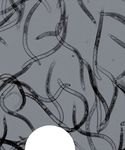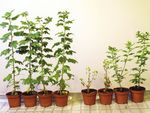JKI Data Sheets Plant Diseases and Diagnosis - OpenAgrar
←
→
Page content transcription
If your browser does not render page correctly, please read the page content below
2017, 1
ISSN 2191-1398
DOI 10.5073/jkidspdd.2017.001
JKI Data Sheets
Plant Diseases and Diagnosis
Sabine WERRES / Monika GÖTZ / Želkoj TOMIĆ / Dario IVIĆ / Francesca PE-
DUTO HAND/ Colette GABRIEL / David McCANN/ Paul W. TOOLEY
Phytophthora on
Chrysanthemum (chrysanths, mums)
Julius Kühn-Institut, Federal Research Centre for Cultivated PlantsImprint
The open access series “JKI Data Sheets – Plant Diseases and Diagnosis“ is a publication that publishes
original papers, pathogen descriptions, findings and reports on biotic and abiotic causes of crop disea-
ses and crop damage.
All manuscripts submitted for publication in the JKI Data Sheets are peer-reviewed by at least two inde-
pendent referees while the anonymity of author(s) is preserved.
All contributions are made available under the Creative Commons licence. This allows you to use and
distribute the whole work or parts of the work at no charge as long as you use it only for noncommercial
purposes, name the author(s) and source(s) and do not modify the work.
Publisher/Editor-in-Chief: Dr. Georg F. Backhaus, Präsident und Professor
Julius Kühn-Institut, Federal Research Centre for Cultivated Plants
Erwin-Baur-Str. 27
D-06484 Quedlinburg
Germany
Managing Editor: Dr. Olaf Hering, Information Centre and Library
Julius Kühn-Institut
Königin-Luise-Str. 19
D-14195 Berlin
Germany
redaktion.datasheets@julius-kuehn.de
Submission of manuscripts: Please go to the journal’s website at
https://ojs.openagrar.de
ISSN: 2191-1398
DOI: 10.5073/jkidspdd.2017.001JKI Data Sheets - Plant Diseases and Diagnosis
3
Sabine WERRES ... - Phytophthora on Chrysanthemum; 2017, 1 ; DOI 10.5073/jkidspdd.2017.001
Importance of Chrysanthemum
Chrysanthemums are ornamentals of worldwide importance in natural habitats
(http://www.discoverlife.org/mp/20q) as well as in horticulture production. Cultivation of chrysan-
themums as ornamentals started in the 15th century in China. During the 17th century Chrysanthe-
mum sp. were introduced to the Western world (http://www.mums.org/history-of-the-chrysanthe-
mum/).
Today Chrysanthemums are mainly produced in Japan and China. In Europe, The Netherlands is the
country with the biggest Chrysanthemum production area (total area 480 ha in 2013; LEI Wagenin-
gen UR, 2015). In the US, the estimated combined revenue from cut flowers, potted florist mums,
and garden mums is of US $200 million (NASS Report April 2016). Chrysanthemums are cultivated
mainly as potted plants and for cut-flowers. The plants are grown in the field and on container
stands, or protected under plastic tunnels or in glasshouses. Hydroponic culture for cut-flower
production is also an important cultivation system in some countries.
Phytophthora species
From Chrysanthemum with characteristic disease symptoms such as wilting, root rot, and stem
canker, the following Phytophthora species have been isolated directly from plant tissue
Phytophthora species Symptoms Reference
symptoms
P. chrysanthemi wilting, root rot Götz et al. 2017; Lin et al. 2017; Naher et al.
2011; Tomić and Ivic 2015; Watanabe et al. 2007
P. cactorum stem canker cited from Erwin and Ribeiro 1996
P. cambivora wilt cited from Erwin and Ribeiro 1996
P. cinnamomi root rot cited from Erwin and Ribeiro 1996
P. cryptogea blight cited from Erwin and Ribeiro 1996
P. drechsleri root rot cited from Erwin and Ribeiro 1996
All of the Phytophthora species isolated from diseased Chrysanthemum have a wide host range
except for P. chrysanthemi, which infects only chrysanths.JKI Data Sheets - Plant Diseases and Diagnosis
4
Sabine WERRES ... - Phytophthora on Chrysanthemum; 2017, 1 ; DOI 10.5073/jkidspdd.2017.001
Disease symptoms (see figures)
Phytophthora species can attack several plant organs and cause different disease symptoms on
Chrysanthemum. The most common symptoms are:
Upper plant part: growth depression, wilting, discoloration of the leaves (on older plants first only
single leaves can show the symptoms)
Stem: necrosis at the stem base
Roots: root rot
Usually the crown symptoms are the first visible symptoms, followed by stem necrosis. Root rot
can remain undetected in the early stages of disease. Disease symptoms can develop rapidly (e.g.
within a week).
Possibility of symptom confusion
The disease symptoms presented in the previous chapter are not specific for Phytophthora in-
fection. Other root pathogens, like Pythium species, can cause identical or similar symptoms,
especially when the plants are stressed (Pettitt et al. 2011). Necrosis at the stem base (and on
other plant parts) is also caused for example by Phoma ligulicola var. ligulicola/Didymella ligulicola
(Pethybridge et al. 2004). To specify the cause of the disease plant samples must be examined in
the laboratory.
Disease development
Disease development depends on several parameters like culture conditions, age of the plants,
cultivar, Phytophthora species/isolate. Especially P. chrysanthemi in particular is very aggressive and
can kill rooted cuttings within a week. When the disease is progressing slowly the very first symp-
tom is reduced growth.
Diagnosis
It is not possible to identify a Phytophthora infection only by disease symptoms. Different diagnos-
tic techniques like direct isolation, molecular and serological methods help to identify Phytoph-
thora as the cause of the disease and to specify the Phytophthora species. Information on Phytoph-
thora diagnosis in general is given for example in http://forestphytophthoras.org/key-to-species,
http://www.phytophthoradb.org/, http://phytophthora-id.org/ and in Martin et al. (2012). For The
diagnosis of P. chrysanthemi see also JKI Data Sheet Phytophthora chrysanthemi. Please contact
your national authorities (see next chapter) for help with diagnosis.JKI Data Sheets - Plant Diseases and Diagnosis
5
Sabine WERRES ... - Phytophthora on Chrysanthemum; 2017, 1 ; DOI 10.5073/jkidspdd.2017.001
What to do in case chrysants are suspected to be infected?
Contact your responsible national authorities
- Examples for European contact addresses: addresses.pdf
- In Germany please contact first your plant protection services; address list see
https://www.julius-kuehn.de/linksammlung/
- In the USA, each state has an in-state based plant disease clinic. To find a lab based on
state, visit: https://www.npdn.org/.
Management and control
For direct control with chemicals contact your national authorities (see chapter above). If fea-
sible, the following measures might help to prevent infection and to keep the plants healthy: no
stagnant moisture in potted plants or bare root cultivation, optimum nutrition and soil aeration.
Disinfect water in hydroponic cultures regularly, e.g. by filtration. High salinity can force root infec-
tion (MacDonald 1984). Although Phytophthora species can invade plant tissue actively any kind of
wounds increases invasion potential.
Recommendations
- EPPO quarantine recommendation
None of the Phytophthora species detected up to now on Chrysanthemum are listed on
any of the EPPO lists http://www.eppo.int/QUARANTINE/Alert_List/alert_list.htm
P. chrysanthemi: EPPO Code: PHYTKR
- US recommendations
http://www.canr.org/newsletter/PhytophthorachrysanthemiNPAGReport20160401R.pdfJKI Data Sheets - Plant Diseases and Diagnosis
6
Sabine WERRES ... - Phytophthora on Chrysanthemum; 2017, 1 ; DOI 10.5073/jkidspdd.2017.001
Literature Cited
Erwin, D. C., and Ribeiro, O. K. 1996. Phytophthora Diseases Worldwide. ASP Press, St. Paul, Minne-
sota 55121-2097, USA.
Götz, M., Ulrich, R., and Werres, S. 2017. First detection of Phytophthora chrysanthemi on Chrysan-
themum indicum in Germany. New Disease Reports 35(6).
https://doi.org/10.5197/j.2044-0588.2017.035.006.
LEI Wageningen UR, M. Rikken 2015. CBI Product Factsheet: Fresh Cut Chrysanthemums in the
European Market. https://www.cbi.eu/sites/default/files/market_information/researches/
product-factsheet-cut-flowers-chrysanthemums-europe-2014.pdf
Lin, S., Martin, D. E., Taylor, N. J., Gabriel, C. K., and Peduto Hand, F. 2017. Occurrence of Phytoph-
thora chrysanthemi causing root and stem rot on garden mums in the United States. Plant Dis.
101(6):1060. https://doi.org/10.1094/PDIS-12-16-1714-PDN.
MacDonald, J. D. 1984. Salinity effects on the susceptibility of chrysanthemum roots to Phytoph-
thora cryptogea. Phytopathology 74(5):621. https://doi.org/10.1094/Phyto-74-621.
Naher, M., Motohash, K., Watanabe, H., Chikuo, Y., Senda, M., Suga, H., Brasier, C., and Kageyama, K.
2011. Phytophthora chrysanthemi sp. nov., a new species causing root rot of chrysanthemum
in Japan. Mycol Progress 10(1):21-31. https://doi.org/10.1007/s11557-010-0670-9.
Pethybridge, S. J., Scott, J. B., and Hay, F. S. 2004. Genetic relationships among isolates of Phoma
ligulicola from pyrethrum and chrysanthemum based on ITS sequences and its detection by
PCR. Austral. Plant Pathol. 33(2):173-181. https://doi.org/10.1071/ap03097.
Pettitt, T. R., Wainwright, M. F., Wakeham, A. J., and White, J. G. 2011. A simple detached leaf assay
provides rapid and inexpensive determination of pathogenicity of Pythium isolates to ‘all year
round’ (AYR) chrysanthemum roots. Plant Pathology 60(5):946-956.
https://doi.org/10.1111/j.1365-3059.2011.02451.x.
Tomić, Ž., and Ivic, D. 2015. Phytophthora chrysanthemi Naher, Motohashi, Watanabe, Chikuo,
Senda, Suga, Brasier & Kageyama - new cause of chrysanthemum disease in Croatia. Glasilo
Biljne Zaštite 15(4):291-300.
USDA, NASS 2016. Floriculture Crops 2015 Summary. http://usda.mannlib.cornell.edu/usda/cur-
rent/FlorCrop/FlorCrop-04-26-2016.pdf
Watanabe, H., Horinouchi, H., Ichihara, I., Kuwabara, K., Watanabe, T., and Kageyama, K. 2007. Oc-
currence of Phytophthora rot of chrysanthemum caused by Phytophthora sp. Ann. Phytopath.
Soc. Japan 73(60).JKI Data Sheets - Plant Diseases and Diagnosis
7
Sabine WERRES ... - Phytophthora on Chrysanthemum; 2017, 1 ; DOI 10.5073/jkidspdd.2017.001
Links to further information
- Randall-Schadel, B. 2016. NPAG Report - Phytophthora chrysanthemi Naher, Hi. Watan.,
Chikuo Kageyama: Crown and root rot of chrysanthemum.
http://www.canr.org/newsletter/PhytophthorachrysanthemiNPAGReport20160401R.pdf
Authors
Sabine WERRES1 / Monika GÖTZ1 / Željko TOMIĆ2 / Dario IVIĆ2 / Francesca PEDUTO HAND3 /Colette
GABRIEL4 /, David McCANN4/ Paul W. TOOLEY5
1
Julius Kuhn Institute – Federal Research Centre for Cultivated Plants (JKI)
Institute for Plant Protection in Horticulture and Forestry (GF)
Messeweg 11/12
D – 38104 Braunschweig, Germany
sabine.werres@julius-kuehn.de, monika.goetz@julius-kuehn.de
2
Croatian Centre for Agriculture, Food and Rural Affaires
Institute for Plant Protection
Gorice 68b
10000 Zagreb
Croatia
zeljko.tomic@hcphs.hr, dario.ivic@hcphs.hr
3
The Ohio State University, Department of Plant Pathology
2021 Coffey Road, Columbus, OH 43210, USA
hand.81@osu.edu
4
C. Wayne Ellett Plant & Pest Diagnostic Clinic & Ohio Department of Agriculture - Division of Plant
Health (this is a co-located lab)
8995 E. Main St., Bldg. 23
Reynoldsburg, OH 43068-3399, USA
gabriel.89@osu.edu; David.McCann@Agri.ohio.gov
5
USDA-ARS, Foreign Disease-Weed Science Research Unit
1301 Ditto Avenue, Fort Detrick, MD 21702-5023, USA
paul.tooley@ars.usda.govJKI Data Sheets - Plant Diseases and Diagnosis
8
Sabine WERRES ... - Phytophthora on Chrysanthemum; 2017, 1 ; DOI 10.5073/jkidspdd.2017.001
Disease symptoms of Phytophthora chrysanthemi on Chrysanthemum
(chrysams, mums)
Symptoms in nurseries
Left, center: in the field (1)
Right: on potted chrysams on a container stand (1)
Symptoms on Chrysanthemum indicum cv. ´Palisade Yellow´ after inoculation with P. chrysanthemi
JKI-050-15-8-01-2-0
Left: Reduction of growth and wilting (2)
Right: Wilting, necrosis at the stem base and root rot (2)
Photos: (1) – Ž. Tomić, (2) M. Götz, S. WerresYou can also read



























































